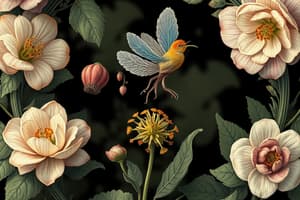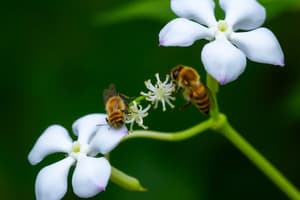Podcast
Questions and Answers
What is the main purpose of pollination in plants?
What is the main purpose of pollination in plants?
- To initiate photosynthesis in flowers
- To transfer pollen grains from anthers to stigma (correct)
- To produce nectar for insects
- To create genetically identical offspring
Which type of flowers usually attract bees and butterflies for pollination?
Which type of flowers usually attract bees and butterflies for pollination?
- Wind-pollinated flowers
- Flowers with small pollen grains
- Insect-pollinated flowers (correct)
- Flowers with heavy pollen grains
What is the outcome of double fertilization in plants?
What is the outcome of double fertilization in plants?
- Formation of endosperm and zygote (correct)
- Development of a triploid embryo
- Formation of two zygotes
- Creation of genetically identical offspring
Which reproductive organ in plants nurtures the developing embryo?
Which reproductive organ in plants nurtures the developing embryo?
What is the main function of sepals in a flower?
What is the main function of sepals in a flower?
Which part of a flower contains the ovules?
Which part of a flower contains the ovules?
Where does meiosis occur in a flower's reproductive system?
Where does meiosis occur in a flower's reproductive system?
Which flower structure contains both male and female reproductive units?
Which flower structure contains both male and female reproductive units?
What is the role of stigma in a flower's reproductive process?
What is the role of stigma in a flower's reproductive process?
Flashcards are hidden until you start studying
Study Notes
Sexual Reproduction in Plants
Sexual reproduction is the most common mode of reproduction among plants. It involves the fusion of two sets of chromosomes from different parents during fertilization, creating a genetically diverse offspring. This process allows for variation within species and increases their resilience against environmental challenges. Let's explore some key aspects of sexual reproduction in plants, including pollination, fertilization, flower structure, and reproductive organs.
Pollination
Pollination is the transfer of pollen grains from the male anthers to the female stigma, initiating the process of fertilization. There are two main types of pollination: wind-pollinated and insect-pollinated. Wind-pollinated flowers usually have small, lightweight pollen grains with simple structures adapted to long-distance transport by air currents. Insect-pollinated flowers, on the other hand, typically produce heavier pollen grains. These flowers often exhibit nectar production, enticing insects like bees and butterflies to visit them.
Fertilization
Once the pollen grain lands on the stigma, it begins its journey through the pistil towards the ovule. During this process, called double fertilization, one sperm nucleus fuses with the egg cell (diploid) to form the zygote, while another sperm nucleus fuses with the central cell (triploid), which eventually develops into the endosperm, nourishing the developing embryo.
Flower Structure
The flower structure plays a crucial role in the successful completion of sexual reproduction in plants. Flowers consist of four main parts: sepals (protecting the young bud), petals (attracting pollinators), stamens (male reproductive units containing anthers), and carpels (female reproductive units containing the ovary). Depending on their pollination strategy, the arrangement of these structures can vary. For example, flowers with a typical structure, such as roses, have separate male and female parts, while those with perfect flowers, like daisies, contain both male and female parts within the same flower.
Reproductive Organs
The reproductive organs, namely the stamen and carpel, play essential roles in the processes of pollination and fertilization. Stamens consist of a filament and anther, which together hold the pollen sacs (anthers). Each anther contains four sporangia, where meiosis occurs leading to the formation of pollen grains. On the other hand, the carpels comprise the ovary, style, and stigma. The ovary houses the ovules, each protected by an integument. As the plant grows, the ovules mature into seeds; the ovary becomes the fruit, which surrounds and protects the seed(s).
In conclusion, sexual reproduction in plants is a complex yet fascinating process involving various stages, including pollination, fertilization, flower structure, and reproductive organs. Understanding these mechanisms helps us appreciate the intricacies of botany and fosters a deeper connection with nature.
Studying That Suits You
Use AI to generate personalized quizzes and flashcards to suit your learning preferences.




